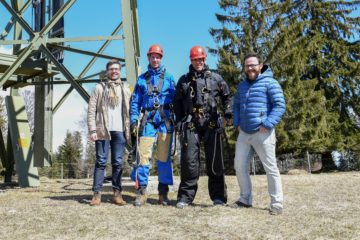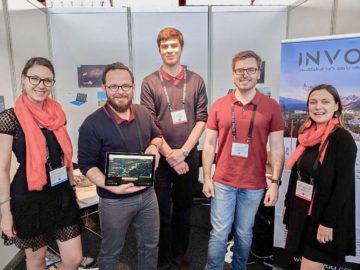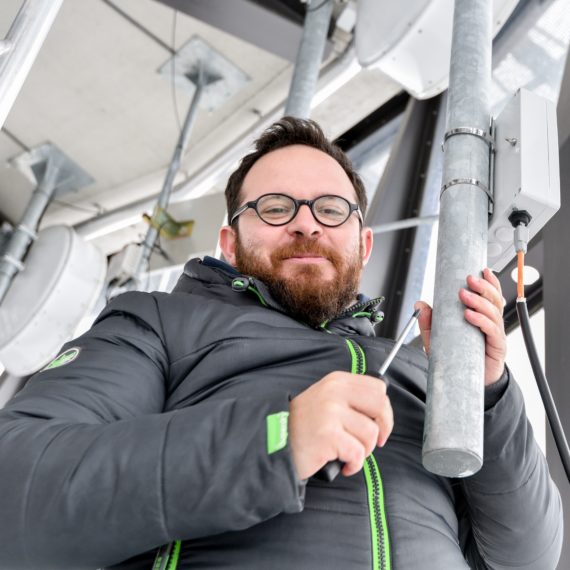Autonomous drones are mostly blind when in flight. But Manu Lubrano and his start-up Involi are now looking to change this – with a network of sensors that monitors the lower airspace sections and acts as an eye for drones. How Involi showed in a pilot project that its data helps prevent accidents involving drones – and how Swisscom learned to mount sensors.
Drones are actually blind, since they can’t see other objects moving in the same airspace. Manu Lubrano hopes to change this with a network of sensors that records the movements of manned aircraft and makes the data available to drones. But the CEO and co-founder of the start-up Involi first had to find out the hard way that not everything on the ground is mapped yet either. “We wanted to be there when the first sensor was mounted to a Swisscom antenna,” says Lubrano.

But the car’s GPS didn’t know the exact location of the site near Premier (Vaud). “We had to refer to Swisstopo’s national maps,” he recalls. “And we then had to walk two kilometres through the mire.” Manu Lubrano and Cyril Mugglin from Swisscom eventually arrived at the antenna – muddy but happy. The pilot project with Swisscom was off to a flying start.
Casting light on lower airspace
There was a good reason for installing the seven sensors for the pilot project – and it can be seen right above our heads: the number of drones is rapidly increasing. And they might also be sharing the skies with self-flying aircraft in the not-too-distant future. At the same time, airspace up to an altitude of 600 metres is not controlled. This means that objects occupying this space have to fly by sight, which presents a problem for the blind drones. The authorities are therefore planning to regulate this airspace in the coming years, making it safe for manned and self-flying aircraft.
Lubrano and his Involi co-founder are now aiming to make reliable and accurate data available for this airspace surveillance with the help of a network of sensors. Autonomous drones will be able to use this information to plan safe flight paths and integrate themselves safely into the air traffic. However, in order to create this network, Involi needs to have sensors in suitable locations.
A visit to NASA
Thus, the idea for their air traffic control solution was born. But where would they find the antennas for mounting the sensors? Well, why not approach a telecommunications service provider that already has a well-developed network of antennas? No sooner said than done. “A month after setting up the company, we applied to enter the Swisscom StartUp Challenge,” says Lubrano. “We saw this as the opportunity to get closer to Swisscom.”

Competing in the StartUp Challenge gave Involi the opportunity to work on developing the business idea together with Swisscom. Small start-up on one side, the mighty Swisscom on the other? Cyril Mugglin, who manages other drone projects with Involi as Swisscom’s Open Innovation Developer, doesn’t see it like that: “We both worked towards the same objective, and we both learned some new things along the way. I felt like I was part of the start-up and was often treated as such.”
Involi was ready for take-off – quite literally at first: as one of the five winners of the StartUp Challenge 2017, the young company flew to Silicon Valley last autumn to meet investors and potential customers. And simply to test the feasibility of their idea. “The most exciting moment for me was visiting NASA. That’s right – NASA!” says Lubrano with a bit of excitement still audible in his voice. “NASA thought we were on the right track. That was a great moment for us.” It certainly made the long round-trip worthwhile.
Seeing and being seen
The collaboration with Swisscom gave rise to the pilot trial, which got underway in January 2018. The seven mounted sensors provided the desired information about the airspace, meaning that Involi now has something concrete to show to interested parties: a 3D airspace model with accurate and reliable data. Meanwhile, the sat nav is still not showing the antenna site near Premier as a point of interest.
“A cool partnership on an equal footing”
Manu and Cyril, you worked together closely on developing Involi. How did the partnership come about?
Manu: I met Cyril at the StartUp Challenge 2017. Since then, we’ve been discussing intensively how telecom service providers can support drone flights and commercial usage. The pilot project gave us the perfect opportunity to test our ideas. Cyril: I’ve known Manu and Involi since last year’s StartUp Challenge. We liked the idea of using air traffic data to make drone flights safer. After the intensive development programme in Silicon Valley, we thought it made perfect sense to conduct a pilot project together.

What were you aiming to achieve with your co-creation?
Manu: The aim was to find out how important airspace data is for drone flights, both in a technical and commercial sense. The data that we recorded during the pilot project could help to prevent collisions between drones and aeroplanes. Cyril: It was a good opportunity to test the sensors in a real-world environment. This helped us learn more about the technical requirements. What’s more, by working together with partners from the industry, we were able to see where the value of the data lies.
You’ve just completed the pilot project. How did it go?
Manu: In my opinion, the pilot was a success. On the technical side, we were able to prove our hypothesis. The quality of the data is good enough to be used for identifying potential collisions. On the other hand, it was very rewarding to see that our data satisfies a real need. Potential customers see it as the missing link for safe drone traffic. Cyril: We learned a lot, including the best way to mount the sensors. We’re very pleased with the pilot project, as it answered all of the biggest questions we had.
How did you find working together on a personal level?
Manu: A lot of work and very exciting. It was cool working with Cyril and the other Swisscom guys. And being able to use their telecommunications infrastructure was amazing. Cyril: One example that shows how we enjoyed a partnership of equals was when I accompanied Involi to a conference and discovered that ‘Involi’ had been printed on my name tag without a second thought. It was clear to us all that this close relationship would speed up the development process.
Helping drones to see – impressions from the pilot project
The project video shows SenseFly, which completes drone flights for professional cartography and relies on data from the lower airspace. The video also provides insights into the test network installation.

